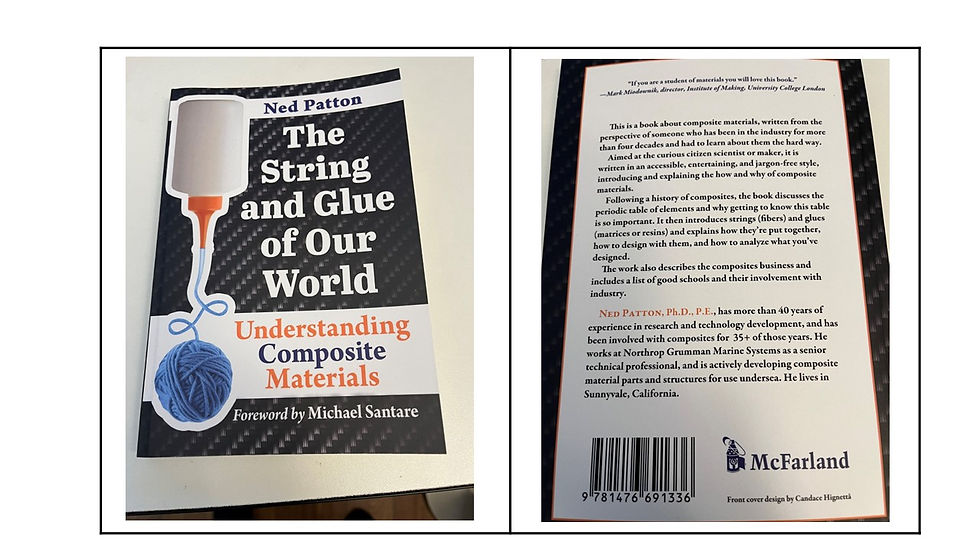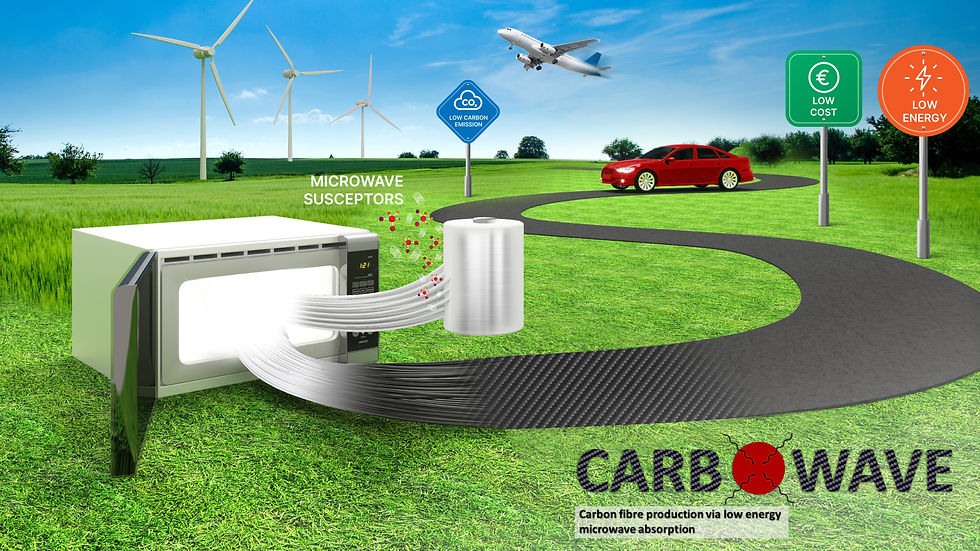Some New and Weird (Maybe?) Plant-Based Textiles that Might End Up in Composites
- Ned Patton

- Jul 15
- 7 min read
My wife sent me a SciShow link this week about some interesting or weird or whatever you want to call them textiles made from some plants that you would not otherwise think of when you think about what your shirt is made of. So I watched it and what occurred to me is that some of these new fabrics have fibers that could be used eventually to make plant-based composites. And, in most cases, the parts of these plants that aren’t fiber have stuff that holds the fibers together, mostly lignin but also some other interesting oily and waxy compounds that could be used as high performance resins. In any case, I thought this might be of some interest to the folks that read these posts. It certainly spiked my curiosity.
First up – one of my favorite weird and wonderful living organisms – the mushroom. Could it be that I grew up in Western Oregon, near where I grew up houses the largest single organism on the planet? There is a 2200 acre fungus whose fruiting body we call the honey mushroom that lives in Malheur National Forest in the Blue Mountains of Oregon. This is an area east of Bend near the border with Idaho in the mountains of Southeastern Oregon. It lives on the plant matter that falls from the pine, fir, and juniper trees whose needles litter the forest floor. And it is at a high enough elevation that the soil in the part of the forest where this mushroom exists is fairly damp year around.
Anyway, this pic is from an article from the East End Group in New York talking about mushrooms and the mycelia that grows beneath the surface whose fibers are called hyphae. It turns out that these mushroom hyphae are strong fibers that can be woven into textiles, and even made into leather. So some day you might be wearing mushroom leather boots. And when your boots are worn out, you can grind them up, put the ground up leather in the dirt and grow more mushrooms. So, these textiles are biodegradable and completely sustainable.
Another plant that has been made into or added to textiles is the leaves of seaweed. It turns out that you can harvest the leaves that are at the surface and the plant will just grow more leaves. So this is also a completely sustainable and renewable fabric.
 |  |
Seaweed Infused Fibers (left) and Fabric (right)
What they are doing with this stuff is to harvest just the top leaves of a brown seaweed or algae that grows off the coasts of Iceland, Norway, and Ireland. They take the harvested leaves, dry them and turn them into a powder that can be added to the cellulose from which a sustainable cellulosic fiber created from wood pulp called Lyocell is made. This hybrid fiber retains the strength and softness of the original cellulosic fiber but has some skin soothing and antibacterial properties from the seaweed.
The other thing that seaweed is being used for, in addition to this textile addition, is to form the basis of a new breed of biopolymers that can be used as resins in plastics manufacturing. Apparently these new seaweed resins are compatible with current plastics manufacturing equipment and they can be made to have the same look and feel of traditional petroleum based plastics. That means that some day we will see seaweed fiber / seaweed resin based natural and completely biodegradable composite materials.
Another plant that you don’t normally think of when you think textiles is the pineapple. We all know what the fruit looks like and that you have to cut off the outer skin to get at the sweet, tangy tropical fruit inside. But the pineapple plant itself has really large leaves that are usually just thrown in the compost. So this is another case of waste organic material that can make a good fiber.

This textile fabric is called Piña and it quite popular in the Philippines. Apparently the texture is like linen or silk, so since linen is flax fiber, it seems like this fiber most probably has properties very similar to flax fiber. So it could very easily be the natural fiber of choice wherever pineapples are grown.

The same is true of the banana plant and its huge leaves. The fibers from these fast growing plant leaves have also been used to make textile fabrics in the areas where bananas grow, so this is another great resource for fiber for reinforcement of composites.
There are actually a few companies that have sprung up to take advantage of these fibers and make them in to textiles. Aranas-anam, a company registered with Lloyds in the UK with sales offices in Spain, which appears to have major operations in The Philippines markets mostly pineapple leaf fabrics but they also have a line of pineapple fiber based leathers like the mushroom leather. They take pride in the fact that they source their fiber sustainably from small subsistence farmers which allows the pineapple farmers to make a profit not only on the fruit they grow, but also on what used to be the waste product of growing pineapples, the leaves that are left behind.
And in the world of bananas, Bananatex® is a fabric material made from the leaves of the Abaca banana plants grown in a permaculture environment in the Philippines. In a permaculture environment, what these growers do is to harvest bananas as they ripen, and then trim back some of the older leaves to allow more bananas and more banana leaves to grow. The bananas are sold on the open market and the trimmed off leaves are turned into fibers, yarns, and finally fabrics.
The point that I am trying to make here is that it appears that as the less developed countries start to realize that their agricultural waste, rather than being burned on the site and polluting an area, can be turned into fairly high technology material products that have the potential to be a very good, sustainable, and renewable source of income for the country and its people. All it is going to take is some ingenuity on the part of some of the local entrepreneurs who are willing to take a risk, learn something about materials and processing of plant waste into useful products, and build real businesses right in their back yard.
And if they don’t get started pretty soon and take control over their agricultural environment to ensure sustainability and renewability, this opportunity may like so many others be irretrievably lost. However, from what I have been able to gather so far, the sign posts are pointing in the right direction because the companies that are advertising these products are all completely on the sustainability and responsible land management bandwagon. That bodes well not only for the people living in these areas, but also for the rest of us because we get to take advantage of the availability of these products in our consumer goods while actually buying something that is helping the world get to a sustainable future.
That’s about it for this week, and it is about time I got off this soap box anyway. As always, I hope everyone that reads these posts enjoys them as much as I enjoy writing them. I will post this first on my website – www.nedpatton.com – and then on LinkedIn. And if anyone wants to provide comments to this, I welcome them with open arms. Comments, criticisms, etc. are all quite welcome. I really do want to engage in a conversation with all of you about composites because we can learn so much from each other as long as we share our own perspectives. And that is especially true of the companies and research institutions that I mention in these posts. The more we communicate the message the better we will be able to effect the changes in the industry that are needed.
I also wanted to remind everyone that’s interested that I will be giving a talk and chairing a session at the ICCM conference (International Conference on Composite Materials) at the Baltimore Convention Center on August 8 if anyone plans on being there. It is being hosted by my alma mater, the University of Delaware to celebrate the 50th anniversary of the founding of the Center for Composite Materials. That’s where I did my doctoral work so I know several of the people who are going to be at the conference. Should be fun.
My second book, which should be out in the spring next year (yes it does take that long and they just finally accepted my manuscript as “delivered”), is a roadmap to a circular and sustainable business model for the industry which I hope that at least at some level the industry will follow. Only time will tell. Since my publisher and I have finally come to agreement about the title for my next book, our daughter has been kind enough to put together a draft of the cover of the book for them to use to come up with a final version. So, I’ve included the approved cover at the end of this post as promised. Let me know whether or not you like the cover. Hopefully people will like it enough and will be interested enough in composites sustainability that they will buy it. And of course I hope that they read it and get engaged. We need all the help we can get.
Last but not least, I still need to plug my first book, so here’s the plug. The book pretty much covers the watershed in composites, starting with a brief history of composites, then introducing the Periodic Table and why Carbon is such an important and interesting element. The book was published and made available last August and is available both on Amazon and from McFarland Books – my publisher. However, the best place to get one is to go to my website and buy one. I will send you a signed copy for the same price you would get charged on Amazon for an unsigned one, except that I have to charge for shipping. Anyway, here’s the link to get your signed copy: https://www.nedpatton.com/product-page/the-string-and-glue-of-our-world-signed-copy. And as usual, here are pictures of the covers of both books.






Comments